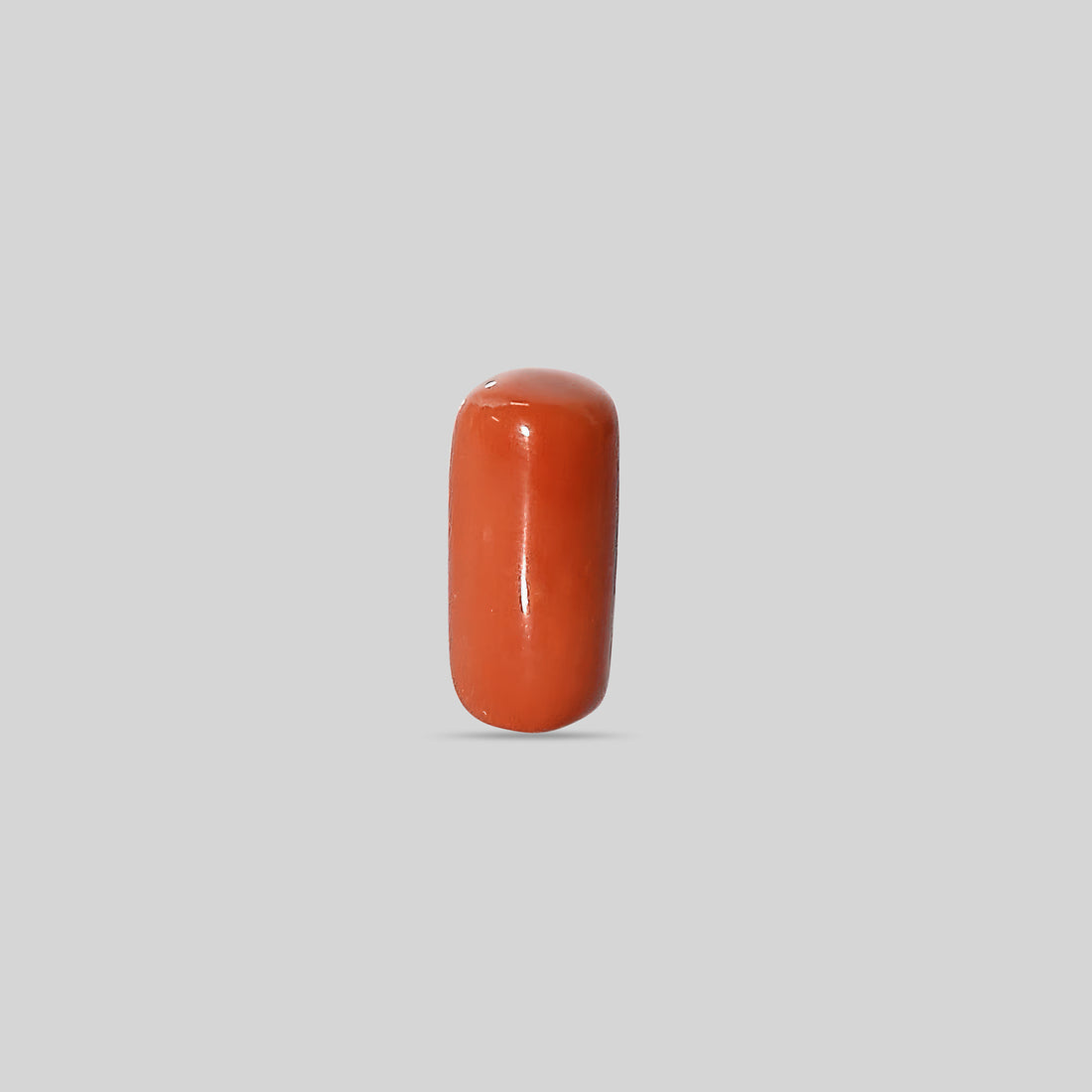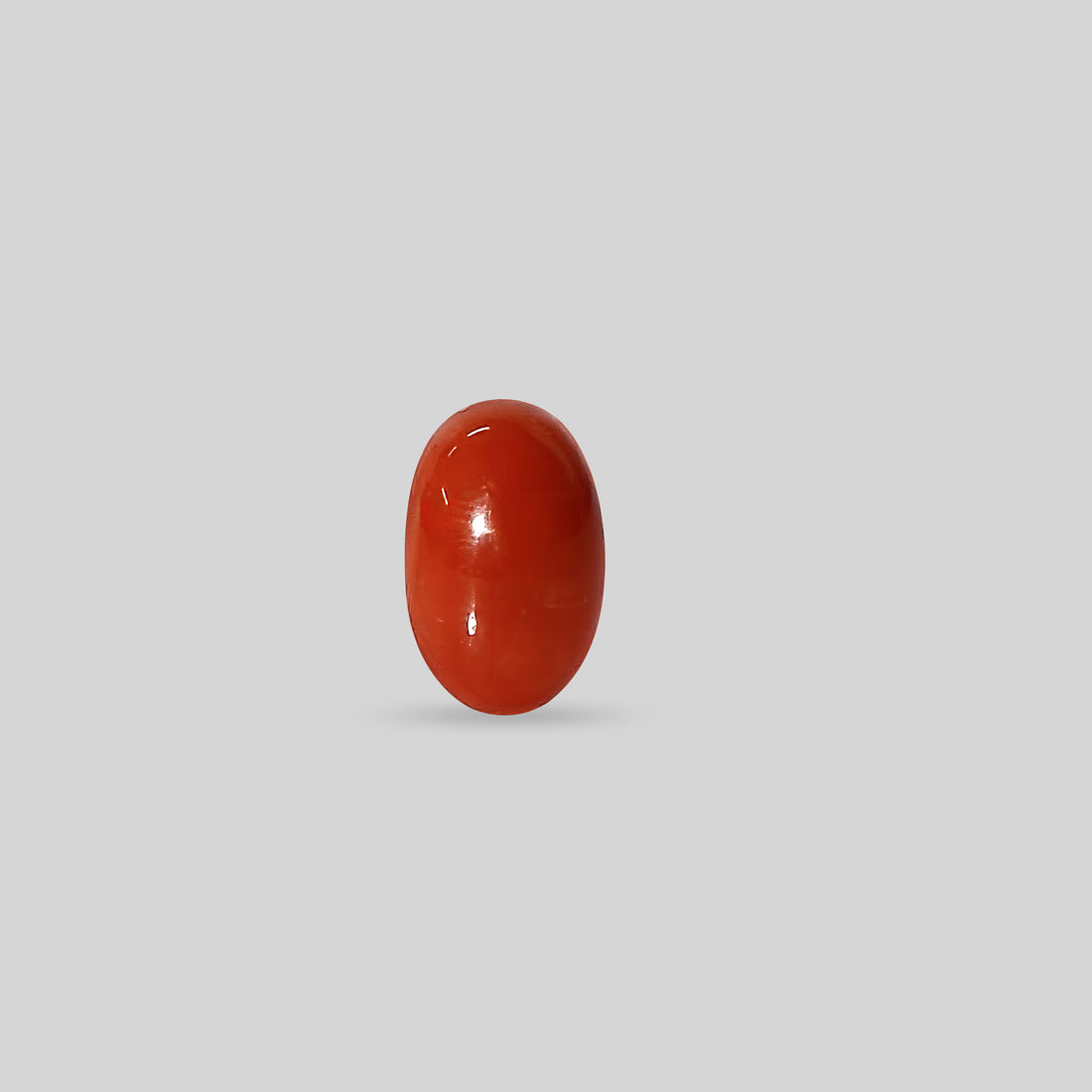This article serves as part of an ongoing series of profiles on the different varieties of precious & semi-precious gemstones. To view the entire list, click here.
Precious red corals, or Moonga stone in Hindi, are marine organisms that belong to a genus of marine corals called Corallium Rubrum. These precious red corals have been highly valued for their beauty throughout history and have been used for centuries in jewelry and decorative items. They have a distinct deep red or pinkish colour, which is attributed to the presence of a pigment called carotenoid. These stones are composed of a calcium carbonate skeleton formed by small individual polyps, similar to other types of coral.
Red corals stand out as a special category of gemstones for 2 reasons. First, they are among the only category of gemstones, other than pearls, that are found underwater, as opposed to all other gemstones such as rubies, sapphires, emeralds, etc. which are mined from within the surface of the Earth. Second, these moonga stones are actually organic gemstones and are non-minerals – meaning that they are produced by living organisms that thrive underwater.
 A Red Coral colony
A Red Coral colony
Fun fact: According to Greek mythology, the red-coloured wavy branches of these corals were said to have been formed from the blood of Medusa – the snake-haired Gorgon, who was cursed by Athena and beheaded by Perseus.
In this exploration of red corals, we unveil their hidden wonders, delve into their mystical meanings, and unlock the secrets of their formation. Keep reading to understand everything you need to know about red corals.
1. Red Corals - Formation & Classifications
Precious red corals form slowly and intricately in deep-sea environments – between 5 and 300 metres underwater. These corals are composed of numerous polyps – which are small animal relatives of sea anemones and jellyfish. Each polyp secretes a calcium carbonate skeleton, which forms the basis of the coral colony. The polyps extract calcium and carbonate ions from seawater, combining them to create a hard skeleton. Over time, as individual polyps die and are replaced by newer smaller polyps, their calcareous skeleton grows larger – eventually forming complex structures that we know as coral reefs.
 Coral polyps are small marine organisms that form into larger colonies
Coral polyps are small marine organisms that form into larger colonies
In general, these red coral colonies grow at a rather sluggish pace - adding only a few millimetres to their growth each year. This growth is influenced by various factors such as the temperature of water, nutrients present, and light penetration. The red colouration of these corals is a result of the pigment carotenoid – which is secreted by local plants, algae, and photosynthetic bacteria.
Red coral reefs are found in specific marine ecosystems, primarily in the depths of the Mediterranean Sea. Along the coastlines of Italy, Greece, and Spain, red corals flourish. Notable regions renowned for their high-quality red corals include Sardinia, Corsica, and Sicily. The suitable water temperatures, depths, and appropriate substrates in these areas create an ideal environment for coral growth. In addition to the Mediterranean, red corals can also be found in the waters surrounding Japan, Taiwan, and the South China Sea. However, their occurrence is limited to specific locations due to the sensitivity of coral reefs to environmental factors.
The fascinating formation process and restricted occurrence of precious red corals contribute to their rarity and desirability in the world of gemstones.
2. Where Are Red Corals Found?
Moonga stones are found in different regions across the globe, each offering unique characteristics and qualities. The Mediterranean Sea, particularly in countries like Italy, Spain, Tunisia, and Algeria, is a renowned source of high-quality moonga stones. The warm waters and favourable conditions in this region contribute to the growth of vibrant red corals.
Japan is another significant producer of moonga stone, particularly from the waters around the islands of Okinawa and Kagoshima. Japanese moonga stones are prized for their deep red hues and excellent quality, often used in traditional and high-end jewelry pieces. These Japanese red corals command a significant value premium because of their quality and rarity.
Other sources of moonga stone include regions in the Pacific Ocean, such as Taiwan, the Philippines, and Hawaii. These regions offer red corals with distinct characteristics and unique colour variations. It's important to note that the distribution of red corals can be limited to specific locations within these regions, and their populations are vulnerable to overexploitation and habitat degradation. Conservation efforts and sustainable harvesting practices are necessary to protect these precious marine organisms and maintain their populations.
3. Are All Red Corals, Indeed Red?
Corals in general occur in a multitude of colours but the precious, gemstone variety occurs in different shades of red. These can range from a light orange-red to a very deep red known popularly as the “Ox Blood” shade in the trade. In general, the deeper and darker the red, the more valuable and expensive is the moonga stone.
 Red Corals occur in a range of reddish tones
Red Corals occur in a range of reddish tones
4. Evaluating the Quality of a Red Coral
When purchasing a moonga stone, several factors determine its quality and value. Here are some key aspects to consider:
- Colour: The colour of a moonga stone is of utmost importance. High-quality moonga stones exhibit vibrant, intense red hues. Stones with deep, uniform colouration and minimal blemishes are generally considered more valuable. Look for stones that possess a captivating red colour. In general, the lighter the red tone of the coral, the cheaper in value it is.
- Lustre: Red corals are usually polished to a glassy finish when they’re manufactured and are often quite lustrous when new. However, over time and with regular wear, this polish wears off significantly, and used moonga stones often have a matte-like texture. As such, look for a red coral that is shiny and newly manufactured, and exhibits a high level of lustre.
- Skin & Texture: Since red corals are grown underwater and are organic gemstones, they often contain minute blemishes or spots in their overall body. Sometimes there are insignificant white-coloured growth patterns that can be visible to the naked eye as well, especially in the case of Japanese red corals. In general, the cleaner the texture and skin of a red coral, the more valuable it is.
- Shape & Size: Moonga stones come in various shapes and sizes. The ideal shape depends on personal preference and the intended use of the stone. Well-defined contours and consistent proportions are desirable characteristics. Larger moonga stones are often more valuable, but individual preferences and budget also play a role in the selection process.
- Origin: The geographic origin of a moonga stone can affect its value and desirability. Red corals from renowned sources like the Mediterranean Sea (Italy) or Japan are often considered superior due to their reputation for high-quality production.
| Mineral | Non-mineral/Organic – composed of Calcium Carbonate |
|---|---|
| Colour Span | Orange-Red, Deep Red, White, Pink |
| Popular Types | Italian, Japanese |
| Mohs Hardness | 3.5 (on a scale of 10) |
| Common Treatments | Dyeing & Bleaching |
| Birthstone | April |
Red Corals (Moonga) - A Quick Snapshot
5. How Much Do Red Corals Cost?
The cost of a moonga stone can vary significantly depending on factors such as quality, origin, and availability. In general, however, Italian red corals begin at about $15 and can go up to $60 per carat. Japanese red corals are relatively rarer and cost significantly more. Japanese red corals begin at about $100 per carat and can go as high as $250 per carat.
6. Red Corals in Astrology
Moonga stone holds significant importance in astrology and is associated with various benefits. In ancient cultures, these gems were believed to enhance physical strength, courage, and protection against evil energies. They are also associated with the Zodiac sign Aries, and are the assigned birthstone for the month of April. In general, red corals are believed to offer benefits such as enhanced energy, courage, protection, and emotional well-being.
 Red Corals (Moonga) in Astrology
Red Corals (Moonga) in Astrology
In astrology, moonga stones are believed to harness the energies of the planet Mars. They are thought to bring balance, stability, and positive relationships to the wearer's life. These gems are often worn as jewelry or kept in close proximity to benefit from their astrological properties.
In general, the moonga stone offers the following benefits in astrology:
- Boosts Energy & Vitality: Red coral is believed to enhance physical strength, energy levels, and overall vitality of the wearer. It is thought to promote courage, motivation, and assertiveness.
- Protection Against Negativity: Red coral is often associated with protection from malevolent energies and warding off evil spirits. It is believed to act as a talisman against negative influences and psychic attacks.
- Confidence & Self-Esteem: It is believed that wearing red coral can help improve self-confidence, assertiveness, and determination. It is said to instil a sense of fearlessness and courage in facing challenges.
- Promotes Passion & Romance: Red coral is believed to stimulate passion, desire, and romantic energies. It is associated with enhancing love, intimacy, and sensuality in relationships.
- Aids in Overcoming Obstacles: Red coral is thought to assist in overcoming obstacles and challenges in life. It is believed to provide the wearer with the strength, determination, and perseverance necessary to surmount difficulties.
























